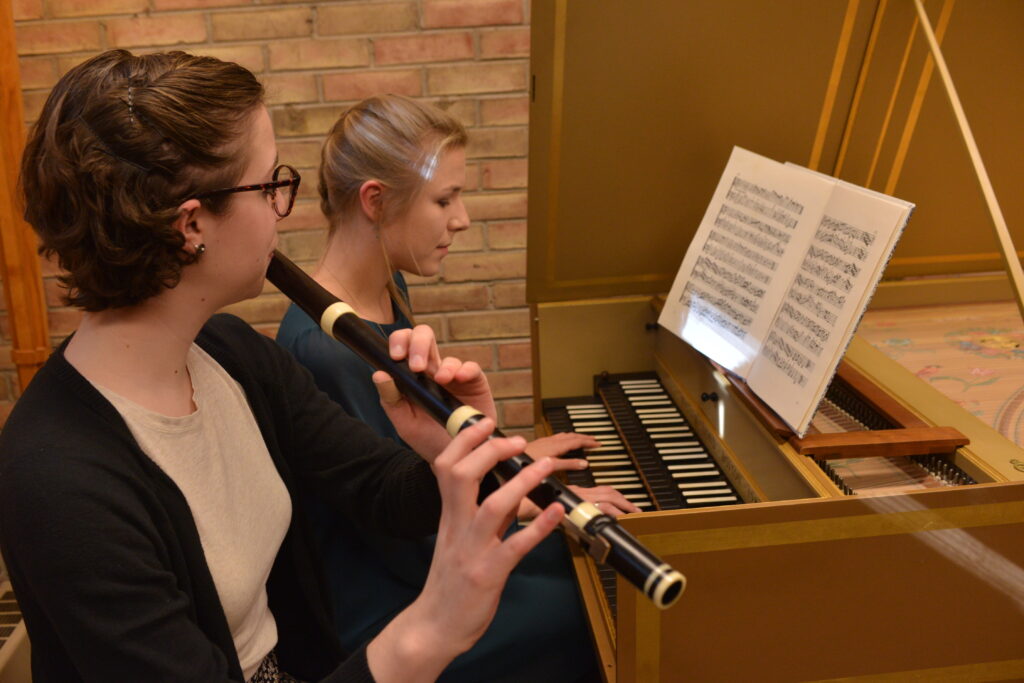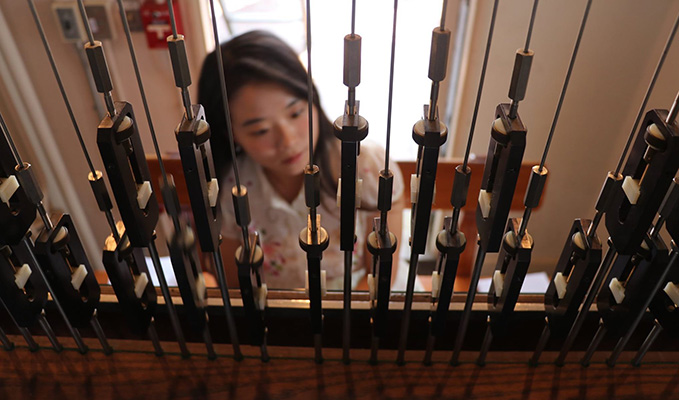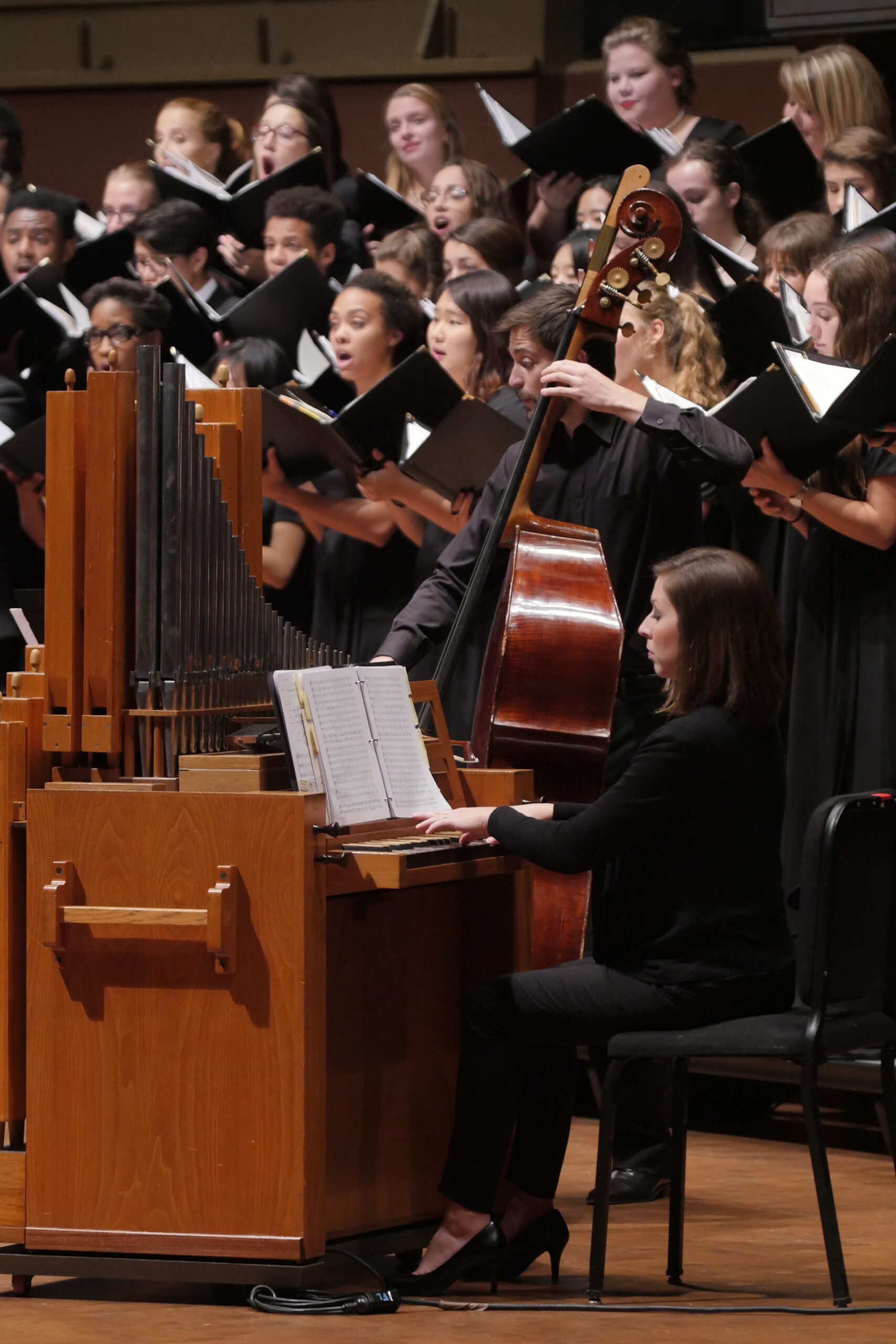Master of Music in Carillon Performance
Offering one of the world’s only master’s degrees in carillon, SMTD prepares its graduate carillon students for professional careers through the development of artistry and technique across a wide range of styles; hands-on experience in arranging, scholarly research, and arts leadership; and intentional cultivation of a repertoire that engages diverse listeners. Within a large and highly active carillon studio, students perform and organize events on Michigan’s two towers with the mentorship of faculty who have made SMTD the leader in diversifying carillon repertoire and championing experimental and electroacoustic music. To apply, applicants should possess a bachelor’s degree in music or its equivalent as well as a strong keyboard background and experience in carillon.
Curriculum
The Master of Music in Carillon Performance requires a minimum of 32 credits. Coursework to include:
- Private carillon lessons
- Private organ or harpsichord lessons
- Music Theory, Musicology, and/or Composition SMTD electives
Final Project:
Recital
Silent Advisor
Degree requirements and term-by-term layout for current students.
Faculty

Joseph Gascho

Nicole Keller

Tiffany Ng

Caroline Robinson
Instruments
All SMTD instruments are available for practice and performances.
Organs

The U-M recognizes the pipe organ as the only instrument suitable for practice and performance of the organ repertoire. Students enrolled for organ instruction perform, study and rehearse on the instruments in Hill Auditorium and the Earl V. Moore Building.
- Frieze Memorial Organ (Hill Auditorium)
- Marilyn Mason Organ (Blanche Anderson Moore Hall, Earl V. Moore Building)
- James Walgreen Organ (Studio 2102, Earl V. Moore Building)
- Studio 2110 (Earl V. Moore Building)
- Practice Organs (Earl V. Moore Building)
- Italian Positiv Organ
- Portativ Organ
- Kistorgel
Additional information may be found in Pipe Organs of Ann Arbor by Professor James O. Wilkes.
Carillons

The University of Michigan has two carillons. A carillon is an instrument of at least 23 bronze bells, arranged in chromatic sequence, so tuned as to produce concordant harmony when multiple bells are sounded together. It is played from a keyboard and pedalboard, which allow expression through variation of touch. Faculty, staff, students, and alumni give regular performances on the campus carillons.
Charles Baird Carillon (Burton Memorial Tower)
53 bells cast by John Taylor & Co. in Loughborough, England and installed in 1936
Ann and Robert H. Lurie Carillon
60 bells cast by Royal Eijsbouts in Asten, the Netherlands and installed in 1996
Practice Carillons
Three practice carillon keyboards are available. Two are located in the upper floors of Burton Memorial Tower, and a digital practice carillon is located in the Duderstadt Center. Practice keyboards are not audible outside of the practice room.
For further information, contact Professor Tiffany Ng, university carillonist. Current students interested in carillon lessons: please visit the Carillon Studio page.
Harpsichords

Students of the harpsichord will graduate as experienced soloists and continuo players, having learned principles of historical performance and how to tune and care for their instruments. The university maintains the following harpsichords for students’ use:
- Keith Hill, 1992: German double manual
- William Dowd, 1984: Franco-Flemish double manual after Ruckers
- Peter Fisk: French double manual
- Hubbard/Eckstein: French double manual
- Hill and Tyre, 1980: German single manual
- David Sutherland: Flemish single manual
- William Post Ross, 1965: Italian single manual after De Quoc
- Two Tuckermann kit instruments
For further information, contact Professor Joseph Gascho.
Performance Opportunities
From large ensembles in celebrated concert halls to chamber groups in intimate recital spaces, performance opportunities across all disciplines abound, with nearly 900 student performances each academic year. Whether your focus is on early, classical, or contemporary music, whether your passion is for jazz, electronic, or world music, there is an ensemble—or in many cases, multiple ensembles—to suit your interests, including specific opportunities for percussion, piano, and organ & carillon. For students in theatre & drama, musical theatre, dance, and opera, opportunities abound in both professionally produced and student-run presentations.
Carillon Recitals and Events
Afternoon carillon recitals
Half-hour recitals are given on weekdays throughout the academic year and are open to the public to view. Intermediate and advanced carillon students may perform for the campus regularly on these recitals.
Student Guild recitals
The student carillon guild organizes monthly recitals on both towers as well as special themed concerts.
Field trips
The carillon studio regularly goes on a day trip to carillons in the state of Michigan and gives public performances. Students plan the tour in conjunction with the instructor.
Electroacoustic recitals
Carillon students have annual opportunities to collaborate with Performing Arts Technology classes to present new music carillon concerts augmented with electronics and audience interactivity.
Special campus-wide events
Advanced students have opportunities to play the carillon for special campus events. Recent examples include the Diversity & Belonging: Unsung Keyboard Stories conference with the Westfield Society for Historical Keyboards, the Historical Keyboard Society of North America (HKSNA) annual meeting, the Bicentennial Carillon Illumination Inauguration, the Mobile Millennium Carillon concert with handbell ensemble, Resonance and Remembrance: An Interdisciplinary Campanology Symposium, and the Interdisciplinary Conference on Netherlandic Studies.






